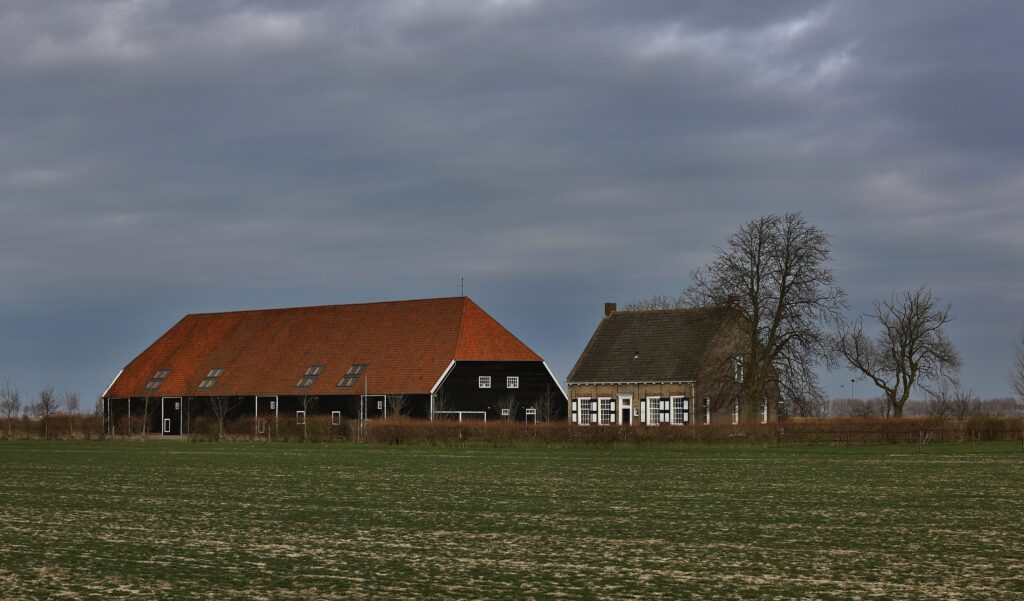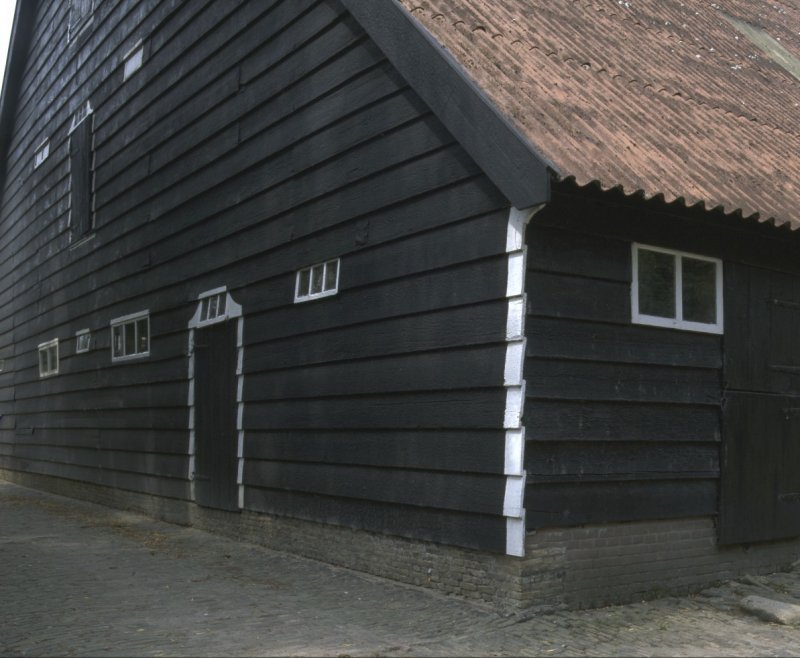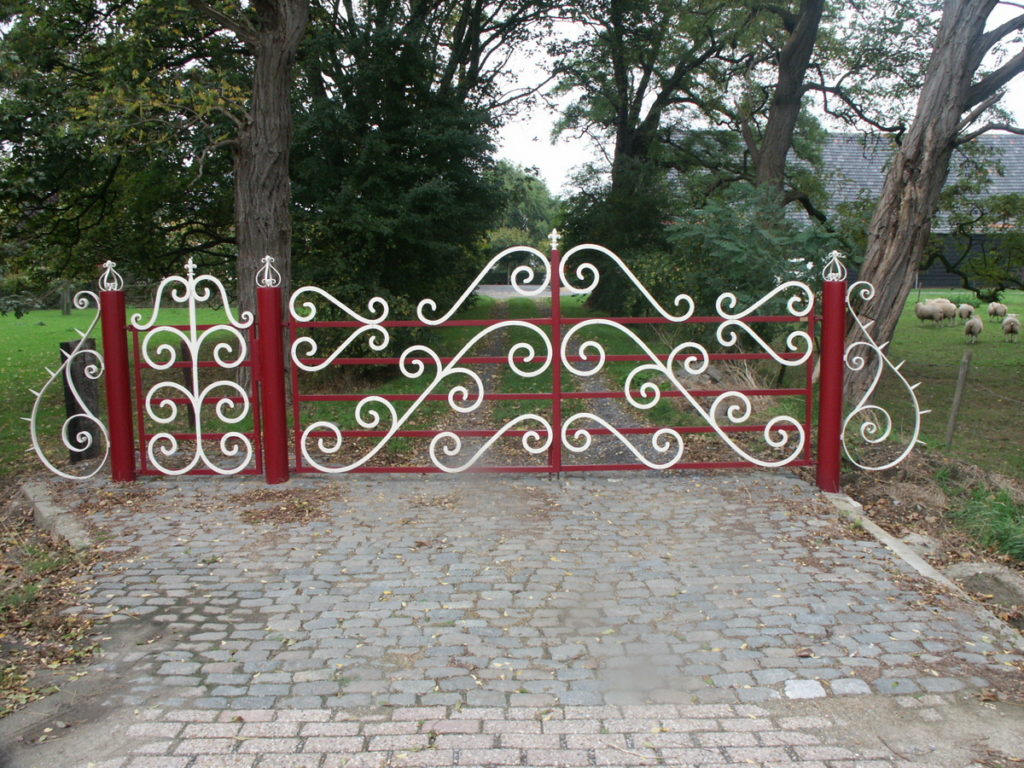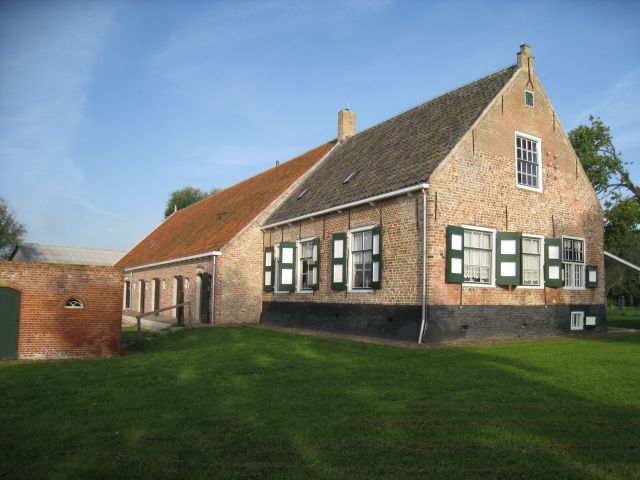Farms
Farming on Zeeland soil has been going on for ages. At Serooskerke, for example, traces have been found of an early-medieval sheep farm with room for around 60 to 80 sheep. Zeeland farmers have historically worked in a very demand-oriented way. And as demands changed, the form of their farms often did too. They would adapt it to the work that they did and to the storage capacity that was needed. You can still see beautiful old farms dotted all over the province. Most of them are still in use, which makes them wonderful examples of living heritage.
Large barns
In the seventeenth century, the demand for agricultural products grew. And so the farmers in Zeeland started to produce even more. This in turn called for more storage and work space, which had an impact on the appearance of the farms. They acquired much larger barns so that they could store more products and still have room to do the threshing in winter.

Farm Land- en Zeezicht in Kamperland (photo Ben Biondina, www.beeldbank.zeeland.nl).
Characteristics of Zeeland barns
Some barns housed livestock, but most of the space was reserved for vegetable crops. Threshed grain was stored on top of the granary to protect it from mice and rats. Apart from their size, other typical features of Zeeland barns are the black tarred and clapboard cladded boards (placed diagonally across each other) and white edging around the doors, which helped people find the entrance in the dark. Often, the large barn doors were also fitted with small doors (klinketten). These also had a white border around them. Incidentally, most of the barns did not have a thatched roof, but a straw roof instead. That was much cheaper. Nowadays there is a building trend in Zeeland where people are attempting to imitate the traditional appearance of the Zeeland barn. There are even campsites where the mobile homes resemble little black barns.

Nieuwlandsrust in Nieuw- en Sint-Joosland (Image bank of the Cultural Heritage Agency of The Netherlands, photo Theo Baart).
Farmyard
On the farmyard, next to the house and barn, there was usually a pigsty and a bakehouse where bread was baked and meals prepared. This was often the place where the maid welcomed her lover in the evening. In any case, these kinds of visits were called ‘bakkêêten’. There were often farm workers’ cottages as well. There are not many of these left, but if they are still standing, they are usually rented out as holiday homes.
From country estate to farmland
After a dip at the end of the seventeenth century, the price of agricultural products rose once more in the eighteenth century. At the same time, many country estates were in dire straits. They offered their land for sale. The plots that had served as gardens or parks until then were ploughed into fields. Additional storage space was needed to accommodate all the extra harvests. This was sometimes solved by adding an extra barn, but often larger ones were built instead. A big barn like this was, much like a big car nowadays, also a status symbol to show off how successful you were. Plantlust and Land- en Zeezicht near Kamperland still have these types of large barns.
Smaller barns
Nevertheless, eventually the barns became smaller again. This had nothing to do with the amount of products being harvested, but rather with the nature of the products. The farmers concentrated more on potatoes and sugar beet, which were not stored in barns. The latter in particular is still grown intensively on Noord-Beveland, and in the autumn you can still see large piles of beet lying beside the fields. If you would like to know more about the barns in Zeeland, you can watch a video clip from the Zeeland canon.
Ornaments
Farmers were not only able to tell a story through the size of their barns. They made symbolic ornaments on and around their farms in order to convey a message in a more ornate way, for example, by using entrance gates, the eaves of barns, shutters, fascias, masonry and wall anchors. Entrance gates were laden with ornamentation and symbolism. Sometimes the name of the farm was incorporated into the ironwork. Symbols such as roosters, lilies or iris flowers, which respectively symbolise repelling storms, purity and light, were also used. The gates on many farms have disappeared – they were a bit too narrow for the large, modern agricultural machinery. If you still spot a beautifully decorated gatepost on a farm driveway, then this is a gatepost on which the fence used to be mounted.

Entrance gate at Zaamslag with a variety of symbolic signs (photo Sandra Dobbelaar).
Special farms
The Oranjepolder farm near Arnemuiden is one of the largest historic farms in Walcheren. It dates back to the turn of the 20th century and was built using brick, which was a sign of prosperity in those days. The farm has a mini campsite where you can stay overnight.
Even more extraordinary is ’t Hof de Dierik near Oudelande. This is the only farm in Zeeland built in the style of the Amsterdam School. The whole complex (a country manor with a staff cottage and several other buildings) is constructed from a distinctive dark brick.
The last owner of Hoeve Van der Meulen was not willing to move with the times and was adamantly opposed to the reparcelling of land. This led to his farm becoming dilapidated, although at the same time, a lot of the authentic details were preserved. The farmstead has been completely refurbished by Het Zeeuwse Landschap and is nowadays a unique piece of farmland heritage, right down to the authentic layout of the landscape. There are tiny fields, lopsided meadows and hedges. The farm has a vegetable garden and an orchard with standard fruit trees. Two holiday cottages have been built so that you can stay overnight at the farm. Het Zeeuwse Landschap also organises regular guided tours here.

The monumental Van der Meulen farmstead in South Beveland has been fully restored.
Goemanszorg in Dreischor is a museum farm. This is where you get to experience farm life in the early twentieth century. You can visit an authentic farmhouse and see how people used to work the land. They have a large collection of agricultural equipment.
Farming today
The vast majority of farms that you see in the countryside nowadays are still in operation – although there are a few where the barn has been converted into a residential home. Many farmers earn extra income from tourism or leisure activities. For example, they have a mini campsite, rent out a cottage or mobile home or even have an indoor playground in one of their barns. As a tourist, you are able to experience farm life from close by during their holidays this way. Another trend is that more and more farmers sell their own products (sometimes in combination with other local products) from their own shops. In a number of cases, you can also get a look behind the scenes as a private citizen. Schellach Kaasboerderij (cheese farm just outside Middelburg), for example, regularly organises farm excursions and you can also take a look at their open cowshed every day.
